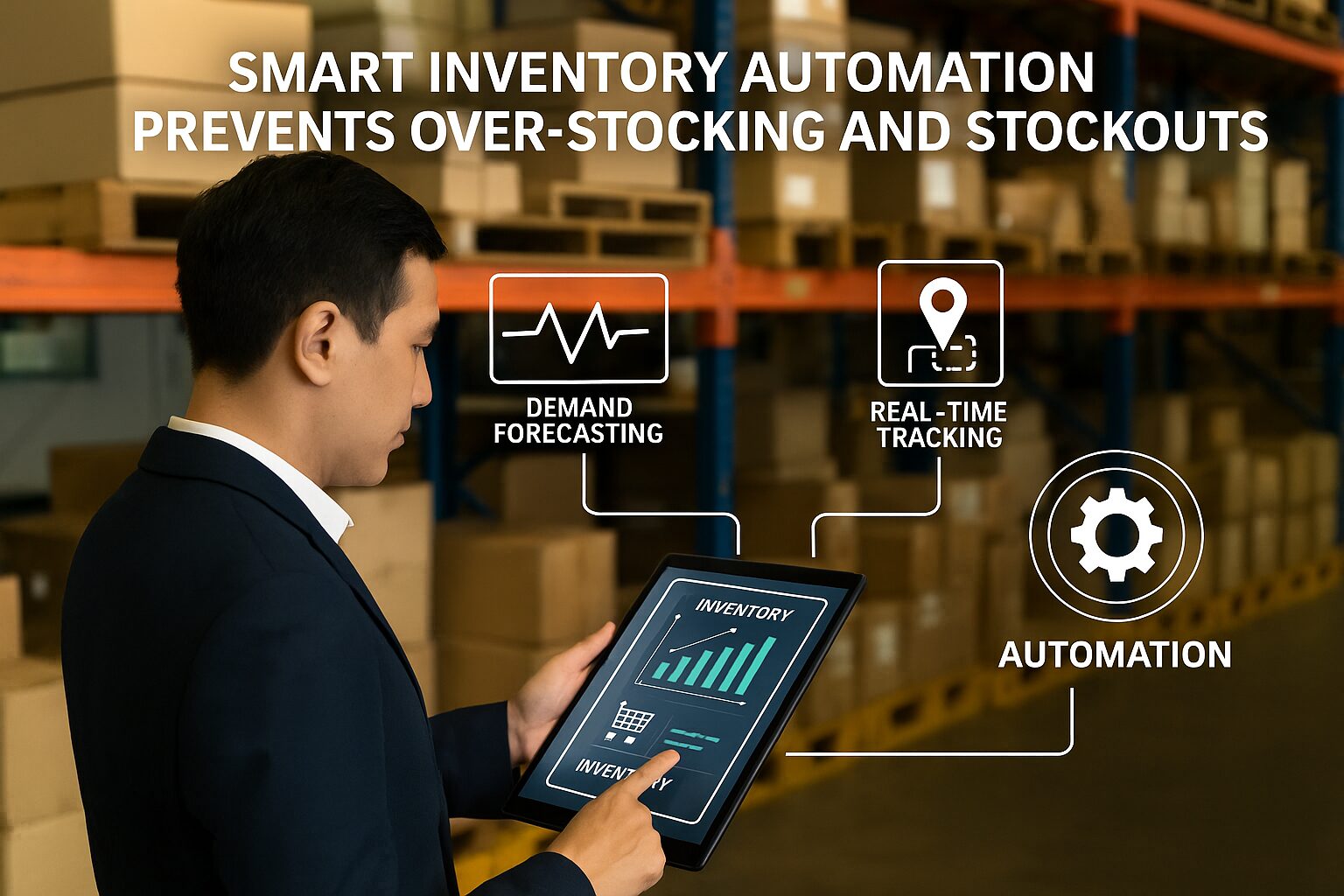
- July 14, 2025
- AxonTrail Editorial Team
- 0
Table of Contents
ToggleHow Smart Inventory Automation Prevents Over-Stocking and Stockouts
In a business environment where customer satisfaction, speed and cost-efficiency are paramount, Smart Inventory Automation is becoming indispensable. From retail chains to manufacturing hubs, stock mismanagement—either excess or shortage—can sabotage your entire supply chain. A smart, automated inventory system ensures that your business operates like a well-oiled machine, with the right stock in the right place, at the right time.
This post explores how Smart Inventory Automation revolutionises stock control, reduces human error, enhances cash flow, and ultimately protects businesses from costly over-stocking and stockouts.
What is Smart Inventory Automation?
At its core, Smart Inventory Automation refers to the use of digital tools and intelligent algorithms to manage stock levels, forecast demand, trigger reorders, and optimise warehouse operations—automatically. Unlike manual systems or basic digital trackers, it combines technologies such as AI, IoT (Internet of Things), cloud computing, and real-time analytics.
It’s not just about counting boxes; it’s about having a dynamic, responsive system that “thinks” with your business and scales with your growth.
The Hidden Costs of Poor Inventory Management
Before diving into the benefits, let’s address what’s at stake. Over-stocking results in:
Tied-up capital
Storage costs
Product obsolescence or spoilage
Waste and write-offs
Meanwhile, stockouts can cause:
Lost sales and unhappy customers
Disrupted production cycles
Tarnished brand reputation
Emergency purchases at higher costs
Smart Inventory Automation eliminates these extremes by creating a real-time balance between supply and demand.

1. Real-Time Stock Visibility
One of the standout features of Smart Inventory Automation is real-time stock tracking. Through RFID, barcode scanning, or IoT sensors, businesses can know exactly what’s in stock, what’s in transit, and what’s selling fast. This instant visibility removes guesswork and prevents both over-purchasing and under-ordering.
Warehouse teams get alerts before stock dips too low or rises too high, enabling proactive decisions rather than reactive firefighting.
2. AI-Powered Demand Forecasting
Gone are the days of static reorder points and seasonally adjusted spreadsheets. Smart Inventory Automation leverages AI and machine learning to analyse historical sales, seasonal trends, promotions, and external factors (like weather or market shifts).
This forecasting allows businesses to stock up in anticipation of actual demand—not guesswork. For example, a beverage company may know that a heatwave is expected in Mumbai next week, and the system suggests increased replenishment of cold drinks to those zones in advance.
3. Auto-Replenishment & Just-in-Time Delivery
With Smart Inventory Automation, restocking becomes an automatic process. The system triggers purchase orders when inventory hits predefined thresholds. This removes dependency on staff manually tracking every item and greatly reduces lead time errors.
For businesses following a Just-in-Time (JIT) model, automation ensures that inventory flows seamlessly without clogging up warehouse space or increasing holding costs.
4. Multi-Channel Synchronisation
Whether you sell through physical stores, an e-commerce platform, or both, Smart Inventory Automation keeps stock levels synchronised. A sale made online immediately reflects in the system, reducing the risk of overselling.
For wholesalers or distributors, synchronisation across warehouses and branches ensures a centralised view and consistent decision-making.
5. Batch & Expiry Tracking
Industries like pharmaceuticals, food, and cosmetics need to manage batch numbers and expiry dates carefully. Smart Inventory Automation can track expiry-sensitive products and alert you before they become unsellable, thus helping reduce wastage.
It also ensures First-In-First-Out (FIFO) practices, keeping your supply chain compliant and quality-focused.
6. Scalability and Adaptability
Whether you’re a small business scaling fast or a large enterprise with complex operations, Smart Inventory Automation adapts to your needs. As order volumes grow, the system handles more transactions, warehouses, and SKUs without additional manpower.
Moreover, updates or reconfigurations are often cloud-based, requiring minimal downtime and zero local IT infrastructure.
7. Centralised Reporting and Insights
A smart system doesn’t just record—it analyses. You gain dashboards and reports showing best-selling products, seasonal demand curves, vendor performance, and dead stock. These insights drive smarter procurement, better sales strategies and more profitable product decisions.
Smart Inventory Automation becomes your strategic partner, not just a backend process.
8. Reduced Human Error
Manual inventory management is prone to miscounts, misplaced goods, and input errors. A barcode mistyped or a forgotten reorder can disrupt operations. Smart Inventory Automation standardises and automates these processes, bringing accuracy rates to near 100%.
This helps reduce returns, refunds, and customer complaints—an underrated yet significant benefit.
9. Integration with Accounting Systems
Modern Smart Inventory Automation platforms integrate seamlessly with accounting software. This allows financial planning and stock management to work in unison, improving cash flow and ensuring accurate GST reporting.
10. Enhanced Supplier Collaboration
Suppliers can be looped into the system for automatic alerts or shared dashboards. This ensures transparency in restocking timelines and builds trust across the value chain.
In certain systems, vendors can even view forecasted needs based on consumption patterns—enabling them to plan better and avoid delivery delays.
Real-World Example: A Kirana Store Goes Smart
Take the case of a local kirana store in Kolkata. Initially managing inventory with handwritten registers and Excel sheets, the store often had piles of expired goods and frequent stockouts of daily essentials.
After adopting a Smart Inventory Automation solution, their sales increased by 22% in just 3 months. The system helped optimise purchases, improve shelf turnover and eliminate expired product losses entirely.
This is the silent revolution happening across MSMEs—and it’s only just begun.
Final Thoughts
In today’s hyper-competitive marketplace, efficient inventory management is not a luxury—it’s a necessity. Smart Inventory Automation ensures you avoid the twin pitfalls of over-stocking and stockouts while optimising resources, cash flow, and customer experience.
Whether you’re running a boutique or a warehouse empire, the future of inventory is automated, intelligent, and seamless.
FAQs on Axontrail Smart Inventory Automation
1. What is Smart Inventory Automation?
It’s the use of AI, analytics, and automation tools to manage and optimise stock levels, demand forecasting, and order management.
2. How does it prevent over-stocking?
By analysing sales trends and real-time data, it avoids excessive purchases and manages reorders efficiently.
3. Will Smart Inventory Automation help avoid stockouts?
Yes, it alerts you before stock runs low and even auto-generates purchase orders to maintain healthy levels.
4. Can small businesses afford Smart Inventory Automation?
Absolutely. Many cloud-based platforms offer affordable plans tailored for MSMEs and start-ups.
5. Does it work for online and offline stores?
Yes, most platforms support omnichannel sales and keep inventory synced in real-time.
6. Is integration with GST billing and accounting possible?
Yes. Modern solutions integrate with accounting tools and ensure GST-compliant invoicing and reporting.
7. How secure is the data in these systems?
Data is typically encrypted and stored securely on cloud servers with regular backups and compliance protocols.
8. What industries benefit the most from this?
Retail, wholesale, manufacturing, pharma, FMCG, and e-commerce sectors see the biggest impact.
9. How long does implementation take?
Depending on complexity, it can take anywhere from a few days to a few weeks.
10. Will it reduce manpower needs?
It doesn’t replace people but allows them to focus on higher-value tasks by removing repetitive manual work.
